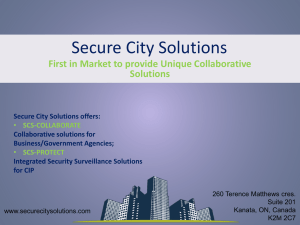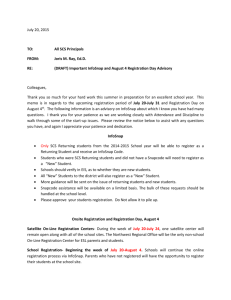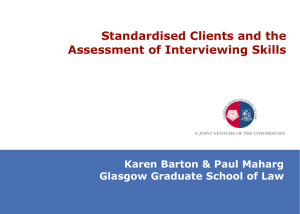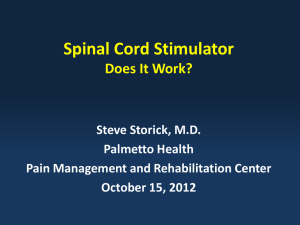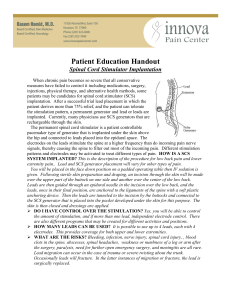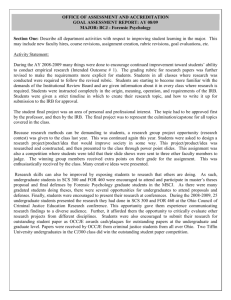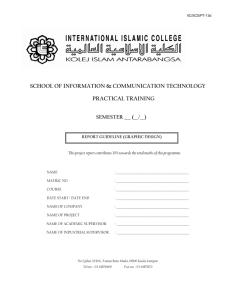PowerPoint Slides - The Association of Law Teachers
advertisement
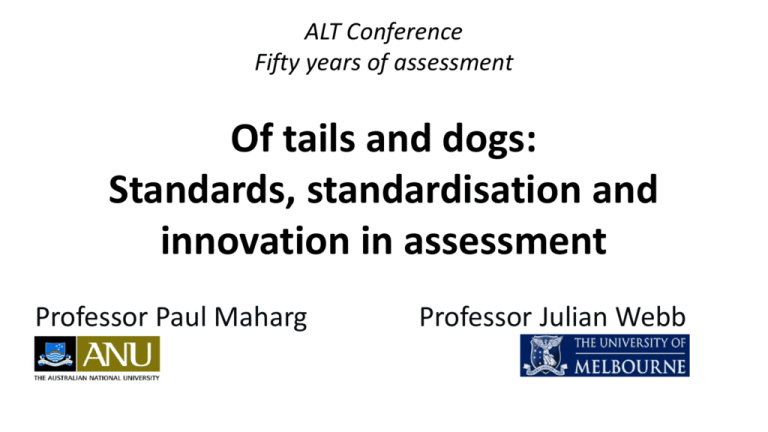
ALT Conference Fifty years of assessment Of tails and dogs: Standards, standardisation and innovation in assessment Professor Paul Maharg Professor Julian Webb preview 1. Legal education reform in the common law world The extent of current activity 2. LETR and assessment The problems and what our Report said 3. Challenging hegemonies Why it’s difficult to change; how we can change 4. Adapting from other disciplines – client-centred assessment Simulated clients 5. Learning from other jurisdictions – the future of digital sim assessment Online digital sims 6. Extreme law schooling NB: Slides available at http://paulmaharg.com/slides 2 1. Legal education reform a view from Australia… 4 reform musical chairs Law Society of Scotland (2006-09) FLSC Task Force (2007-09) LETR (2011-13) (phase 1) ABA Task Force (2012-13) CBA Legal Futures (2012-14) LACC (Australia) (2014-??) SCLE (Hong Kong) (2015?) 5 assessment • Guess how many raised concerns about – standards – Relevance/currency of education and training to practice • Guess how many linked these explicitly to assessment? 6 2. LETR on assessment the problems • Assessment culture: the ‘alternative medicine’ approach – – – – – Most of its been around for years We can apply some fancy names and theories to it to give it legitimacy We think (some of) it does some good [or at least no harm] We like it [more than the other alternatives] More on the consequences of this later…. • Absence of much reliable research (weak evidence base) – – – – Small scale qualitative studies Under-/undefined success criteria Few longitudinal studies or follow-ups (recency effects and other biases) Few systematic attempts at replication or meta-analysis 8 what we said 4.50 “a move to OBET … may improve reliability of assessment techniques, rather than the reverse” 4.111 “Existing assessment strategies tend to focus on conformity as a proxy for consistency” Outcomes, shared standards and standardisation 4.123 There is a legitimate regulatory interest in ensuring that assessment is robust. It must be capable of assessing that which it sets out to assess (valid); it must produce consistent and replicable results (reliable); and it must assess against the syllabus and learning outcomesthat have been set out (fair) 4.123 “Standardisation … can be achieved by extending the number of credible judgments in respect of a task, and by ensuring that those judgments are collected and evaluated systematically” 9 the ‘solution(s)’ Not really, but: 4.145 Assessment is at the heart of LSET since it provides the key means of demonstrating that outcomes have been met. LSET requires more robust and more creative approaches to assessment. The report therefore makes recommendations to ensure that legal values are assessed pervasively, and legal writing and critical thinking assessed discretely at the academic stage (or its equivalent). It proposes ways in which client communication skills could be assessed more realistically; it also suggests that the greater integration of classroom and workplace learning would increase the reliability and practice validity of the assessment of professional skills. 10 3. Challenging hegemonies conventional teaching & assessment If learning … then assessment is often… 1 Is teacher-focused Teacher-centred, not learner-centred. 2 Follows a transmission model of education Focused only on what’s supposed to have arrived / been delivered 3 Focuses only on the individual Individual, alienating, where collaborative, peerreview or self-review can’t take place 4 Consists of monolithic & substantive law content Lacking interdisciplinarity, with little assessment of skills, values, attitudes as well as knowledge 5 Sits in the contested relations between practice & academy Problematic, because content & forms of academic assessments can’t transfer well to professional learning and formation of identity signature pedagogies assessments Surface structure • Observable, behavioural features Deep structure Sullivan, W.M., Colby, A., Wegner, J.W., Bond, L., Shulman, L.S. (2007) Educating Lawyers. Preparation for the Profession of Law, Jossey-Bass, p. 24 • Underlying intentions, rationale or theory that the behaviour models Tacit structure • Values and dispositions that the behaviour implicitly models Shadow structure • The absent pedagogy that is, or is only weakly, engaged 13 transforming learning and assessment: four key themes Experience of… Ethics in… •law in the world •interdisciplinary trading zones •creative, purposeful acts •an integrated curriculum •habitual action •reclamation of moral spaces in the curriculum Technology for… Collaboration •our discipline, our curricula •learner-centred control •transactional learning between… •students •institutions •academic & professional learning •open-access cultures 14 4. Adapting from other disciplines – client-centred assessment standardised client initiative We train lay people to simulate clients, and do two things well: – Discuss their case with the (trainee) lawyer in a way that is standard across the cohort of students/lawyers that the SC meets – Assess the client-facing skills of the lawyer. 16 evidence from medical education • Large body of research literature criticised oral exams beginning in 1960s • ‘A test that is not reliable cannot be valid’ e.g. NBME (USA) studies exams of 10,000 medical examiners over 3 years and found correlations between 2 examiners in one encounter <0.25 • Use of Standardised Patients since 1963 • Now used in high-stakes competency examination for licensure in USA and Canada • Extensively used in final exam ‘OSCE’ stations in UK medical schools 17 SCI project aims • develop a practical and cost-effective method to assess the effectiveness of lawyer-client communication that correlates assessment with the degree of client satisfaction. • ie answer the following questions… – Is our current system of teaching and assessing interviewing skills sufficiently reliable and valid? – Can the Standardised Patient method be translated successfully to the legal domain? – Is the method of Standardised Client training and assessment costeffective? – Is the method of Standardised Client training and assessment more reliable, valid and cost-effective than the current system? 18 SC project conclusions… • • • • Use of SCs is as reliable and valid as tutor assessments We make what the client thinks important in the most salient way for the student: a high-stakes assessment where most of the grade is given by the client We did not conclude that all aspects of client interviewing can be assessed by SCs – We focused the assessment instrument on aspects we believe could be accurately evaluated by non-lawyers – SCs are also trained to give feedback to students This has changed the way we enable students to learn interviewing… Barton, K., Cunningham, C.D., Jones, G.T. and Maharg, P. (2006) What clients think: standardized clients and the assessment of communicative competence, Clinical Law Review, 13(1), pp. 1–65. 19 feasibility? cost? impact? Feasible…? • Very: lots of experience out there in at least 12 centres. Initial and refresher training needed for SCs, but no high-maintenance. Cost…? • Training of SC trainer + SCs; payment of SCs. • SC documentation is freely available under Creative Commons Impact…? • Big: on students, on ethical performance, practice of skills within professional value contexts; formative and high-stakes assessment. • Also on regulatory bodies, eg Law Society of Scotland, SRA 20 who uses SCs? Strathclyde University Law School (DLP) WS Society (Edinburgh) University of New Hampshire (Daniel Webster Scholars programme) The Australian National University College of Law (GDLP) Northumbria U Law School, LLB Kwansei Gakuin U Law School, Osaka SRA (Qualifying Lawyers’ Transfer Scheme, QLTS) Hong Kong University Faculty of Law (PCLL) Law Society of Ireland (CPD) The Chinese University of Hong Kong Law School National Skills Centre for Social Care, London University of Adelaide Law School (LLB) 21 who uses SCs? Strathclyde University Law School (DLP) WS Society (Edinburgh) University of New Hampshire (Daniel Webster Scholars programme) The Australian National University College of Law (GDLP) Northumbria U Law School, LLB Kwansei Gakuin U Law School, Osaka SRA (Qualifying Lawyers’ Transfer Scheme, QLTS) Hong Kong University Faculty of Law (PCLL) Law Society of Ireland (CPD) The Chinese University of Hong Kong Law School National Skills Centre for Social Care, London University of Adelaide Law School (LLB) 22 Daniel Webster Program • Two-year Bar practicum • Students educated in professional skills and judgment through simulated, clinical and externship settings • Exposure to numerous fields, including real estate, business, and litigation is offered. • Instead of a two-day bar exam, the programme provides a two-year, comprehensive exam in conjunction with the training received. • Students who complete the program are certified as having passed the New Hampshire Bar examination, subject only to passing the Multistate Professional Responsibility Examination (MPRE) and the New Hampshire character and fitness requirements. 23 who uses SCs? Strathclyde University Law School (DLP) WS Society (Edinburgh) University of New Hampshire (Daniel Webster Scholars programme) The Australian National University College of Law (GDLP) Northumbria U Law School, LLB Kwansei Gakuin U Law School, Osaka SRA (Qualifying Lawyers’ Transfer Scheme, QLTS) Hong Kong University Faculty of Law (PCLL) Law Society of Ireland (CPD) The Chinese University of Hong Kong Law School National Skills Centre for Social Care, London University of Adelaide Law School (LLB) 24 QLTS assessment regime Assessment consists of: • The Multiple Choice Test (MCT) • The Objective Structured Clinical Examination (OSCE) • The Technical Legal Skills Test (TLST) 25 OSCE Tests the oral skills of interviewing and advocacy/oral presentation together with the three content areas of: – Business – Civil and criminal litigation – Property and probate Components of the OSCE Each candidate completes three stations in each content area: • Station 1: Client interview and completion of attendance note • Station 2: Client interview and completion of attendance note • Station 3: Advocacy/oral presentation 26 test quality of simulated clients? ‘Overall the test quality is remarkably good for such a new set of assessment procedures and challenging targets for a new high stakes assessment have largely been met.’ Eileen Fry , Jenny Crewe & Richard Wakeford (2012) The Qualified Lawyers Transfer Scheme: innovative assessment methodology and practice in a high stakes professional exam, The Law Teacher, 46:2, 132-145, p.144. 27 is it a valid & reliable assessment? ‘Assessment by standardised clients proved to be very reliable, with the six standardised client assessments conducted for each candidate by a total of 45 different actors having an alpha coefficient of 0.81 and SEm of 5.07% in OSCE #2.’ Eileen Fry , Jenny Crewe & Richard Wakeford (2012) The Qualified Lawyers Transfer Scheme: innovative assessment methodology and practice in a high stakes professional exam, The Law Teacher, 46:2, 132-145, p.144. 28 SCs: people as co-producers, codesigners The SC approach challenges: 1. 2. 3. 4. 5. 6. 7. 8. 9. 10. 11. Curriculum methods Ethics of the client encounter The cognitive poverty of conventional law school assessment Law school as a self-regarding, monolithic construct Law school categories of employment The curricular isolation of clinic within law schools Hollowed-out skills rhetoric Conventional forms of regulation by regulatory bodies The role of regulator, as encourager of innovation & radical reform…? Disciplinary boundaries – what about a SC Unit that’s interdisciplinary? Local jurisdictional practices: how might such a project work globally? 29 5. Learning from other jurisdictions – the future of digital sim assessment Transactional Learning active learning through performance in authentic transactions involving reflection in & on learning, deep collaborative learning, and holistic or process learning, with relevant professional assessment that includes ethical standards 31 what are we assessing in simulation? • • • • • • Professionalism and ethical performance Skilled performance to benchmarked levels Substantive knowledge of law Procedural knowledge Many other categories of assessable experience Purpose of assessment: – Formative (feedback and feedforward) – Summative Think of a social space where both workspace, learning space & assessment space co-exist, eg, between master & apprentice. 32 how are we assessing in sims? 1. Discrete tasks, eg drafting, letter-writing, research (Estate Planning transaction) 2. Whole file + performative skill (Personal Injury transaction) 3. Tasks + whole file (Property or Planning transaction) 4. Tasks + file + performative skill (Litigation transaction) 33 1. discrete tasks • Set context (or not: let student figure that out – the clearing in the forest…) • Set task (but in how much detail? Supported with templates? Guidelines? Commented examples?) • Design feedforward (but don’t do the task for students) • Deadline a task (bearing all contextual factors in mind) • Task completed (and sent by students to staff in role) • Feedback on task (by staff in role) • Debrief (either in role or out of role) 34 2. whole file + performative skill • Holistic assessment of document chain • Bodies of evidence generally, but can embed critical points of assessment, eg report to client, speech plan, etc • Preparation for performative skill, including overlap with other skills – eg relation of legal research to professional negotiation. 35 3. tasks + whole file • Specific tasks are the foreground, eg draft the completion certificate… • … but students must also complete entire file process. No completion, no competence. • Tasks may shadow tutorial work or precede tutorial work or neither • Quaere: How many attempts at each task? 36 4. tasks + whole file + performative skill • Most complex, most authentic and most demanding • Potentially 1-3 plus more – eg performative skill can be assessed in role. 37 Practice Management @ ANU Legal Workshop includes work on… Developing professional identity • Meeting deadlines, courtesy in communications • Practice Organisation skills • Ethical obligations Supporting disruptive pedagogy Thanx Anneka & Liz • Team work • Time, file and risk management Enhancing wellbeing • Identifying responses and feeling comfortable with uncertainty • Giving Voice to Values (GVV) – by Mary Gentile, Babson College 38 feasibility? cost? impact? Feasible…? • Yes: following the SIMPLE project, ANU Legal Workshop created a Virtual Office Space (VOS) and other environments, and now runs an online Professional Practice Course for over 1,000 students. Cost…? • Development of environment + sims; learning support for students • Staff costs; training costs. Impact…? • Big: on students, on ethical performance, practice of skills within professional value contexts; formative and high-stakes assessment; transactional learning; learning by doing (Dewey) 39 6. Extreme law schooling new programme designs • Eg p/g JD or LLB + PBL + online + lifelong learning: – – – – – – New 3 year curriculum: 1+2 (qualifying subjects) + 3 (Masters options). Integration into clusters of traditionally separate subjects Focus on collaborative problem-solving using a PBL methodology Learning intellectual structures through problem immersion Fusing learning and immersive, integrative assessment Healing the academic / professional divide, in design and in new forms of employment (adjuncts as trained PBL facilitators) – Opening up choice of career pathways – Possibility of global partnerships with other innovative PBL centres. 41 assessment? Integrative assessments are essential: • Exams that embed course elements • Skills that fuse with knowledge items • Integration of SCs and Transactional Learning • Evaluation where formative becomes the new summative • Ethics & social justice are threaded through an entire programme, via problems & assessments • Use of predictive data & analytics • Use of blockchain technologies 42 Email:paul.maharg@anu.edu.au julian.webb@unimelb.edu.au Slides: paulmaharg.com/slides 43
